Best Basic Frittata Recipe
- By Jennifer Segal
- Updated February 5, 2024
- 52 Comments
- Leave a Review

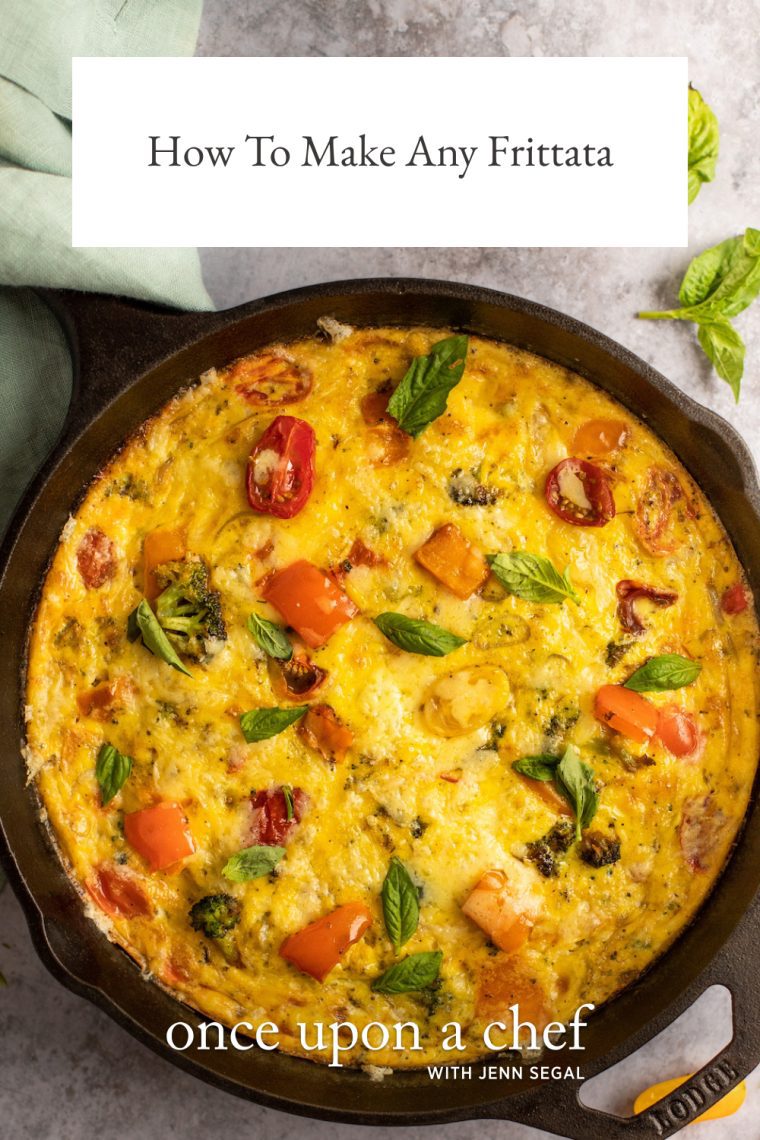
This post may contain affiliate links. Read my full disclosure policy.
Turn yesterday’s leftovers into today’s delicious meal with this easy frittata recipe. I’ll share my technique and tips for making the best frittata, along with plenty of filling ideas. This is a great recipe for getting creative in the kitchen!
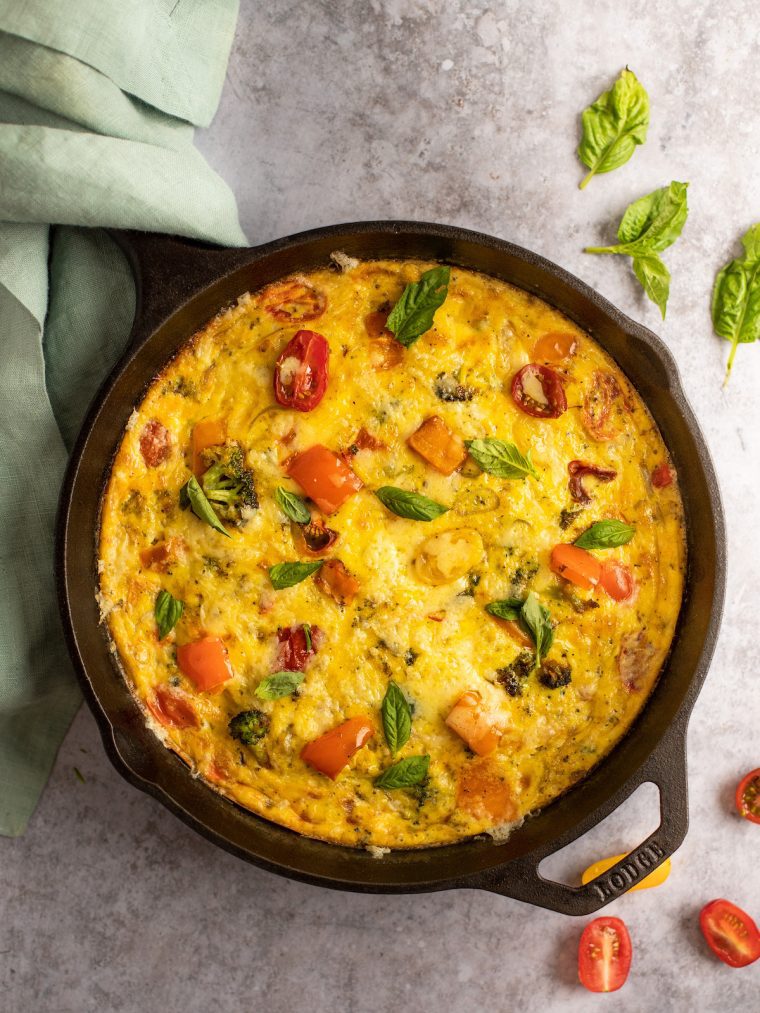
I think of frittatas as the lazy cook’s omelette, perfect for those nights when eggs and a few odds and ends are all you’ve got in the fridge. They’re so simple to whip up without the precise technique omelettes require. But just because they’re easy doesn’t mean you’re skimping on flavor. Like their omelette and breakfast casserole cousins, frittatas offer endless possibilities for add-ins. You can toss in whatever veggies, meats, herbs, or cheese you’ve got lying around—it’s one of those clean-out-the-fridge meals that somehow always turns out great.
Frittatas can be served for brunch, lunch, or a light dinner, and you can even prepare them in advance. Plus, they’re delicious both warm and at room temperature, so extra slices make a great grab-and-go lunch or a no-fuss picnic option. Below, I’ll share my formula and suggestions for making the best frittata, as well as some options for fillings. As long as you follow the basic steps, it’s all about using what you have and getting creative—have fun with it!
“Delicious! I used a cast iron skillet just like Jenn and added caramelized mushrooms, power greens, bacon, and sharp cheddar cheese. This will be on rotation for sure.”
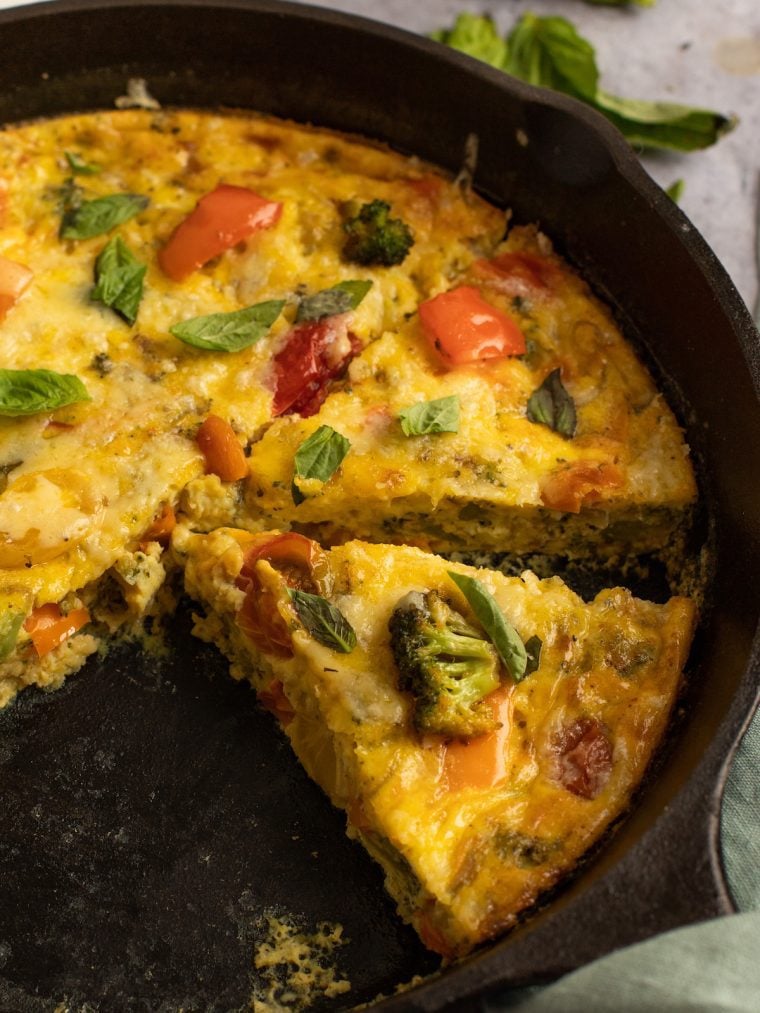
Frittata Filling Ideas
- Veggies: ratatouille, bell peppers, broccoli, mushrooms, zucchini, onions, asparagus, potatoes, tomatoes, garlic, leeks, eggplant, and shallots.
- Leafy Greens: arugula, spinach, kale, collard greens, Swiss chard, endive, and beet greens.
- Herbs: Parsley, chives, dill, thyme, basil, or herbes de Provence.
- Cheese: Gruyère, Cheddar, Swiss, or fontina (Parmigiano Reggiano can be used in combination with any of these options).
- Meat/Seafood: bacon, pancetta, sausage, salami, ham, chicken, turkey, smoked salmon, and crab meat.
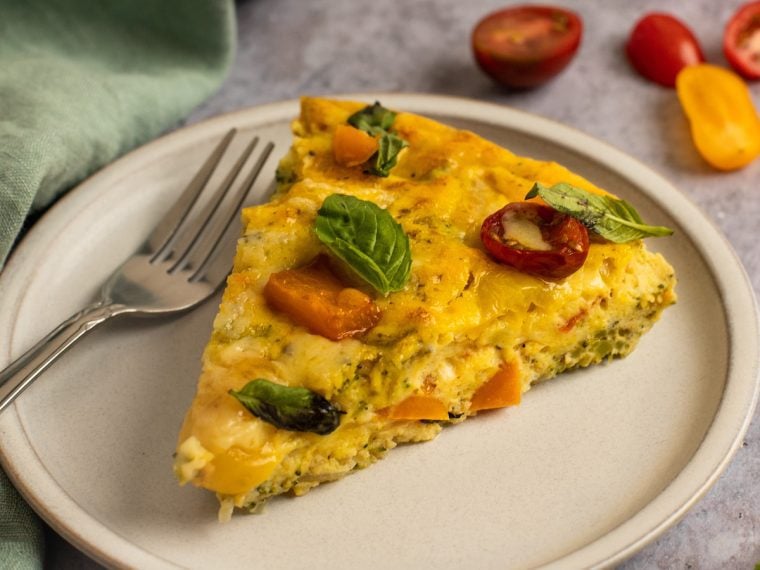
Pro Tips For Making The Best Frittata
- Use the right pan: A nonstick, oven-safe skillet is ideal—cast iron works great too. If you don’t have one, a 9×9-inch baking dish or deep-dish pie plate gets the job done.
- Keep your add-ins small: Chop ingredients like veggies or bacon into small pieces so they cook evenly and don’t weigh down the frittata.
- Season your veggies: If your vegetables are raw, give them a quick sauté and a pinch of salt before adding them to the egg mixture. If they’re already cooked, just drain off any extra liquid.
- Cook low and slow: Most frittata recipes call for an oven temperature of 350°F, but this is too hot. Like quiche, frittatas should cook at 325°F so that the eggs maintain a custardy texture.
- Watch that pan handle: As soon as the frittata comes out of the oven, toss an oven mitt over the handle so you don’t accidentally grab it (seriously, it happens!).
- Finish it off: Add something fresh or flavorful on top like chopped fresh herbs, a little pesto sauce, hot sauce, warm salsa, or even a lightly dressed arugula salad.
What You’ll Need To Make A Frittata
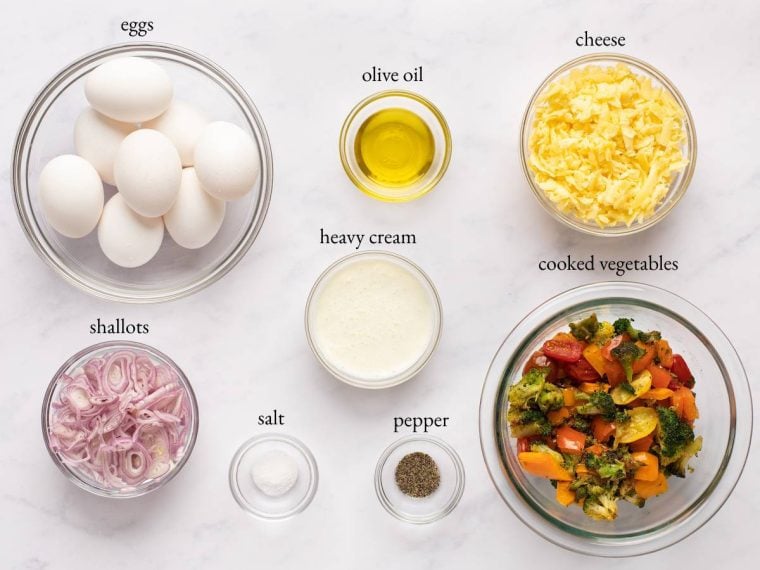
- Shallots: Bring a mild, slightly sweet onion flavor.
- Cooked Vegetables or Greens: Add color, texture, and a little extra nutrition. Use whatever you have—leftovers work great and make it easy to mix things up.
- Eggs: The base of the frittata, giving it structure, richness, and protein.
- Heavy cream: Makes the eggs extra creamy and rich. For those who would prefer to use half & half, it will work; just keep in mind that the frittata will be slightly less creamy.
- Shredded Cheese: Melts into the frittata, adding flavor and a gooey texture—just be sure to use a cheese that melts well. Try Cheddar for sharpness or Gruyère for a mellow, nutty note—or use both!
- Jump to the printable recipe for precise measurements
Step-By-Step Instructions
Step 1: Cook the shallots. Heat the oil in a 10-inch cast iron or oven-safe nonstick skillet over medium heat. Add the shallots and cook, stirring often, until softened but not browned—it should take 3 to 4 minutes.
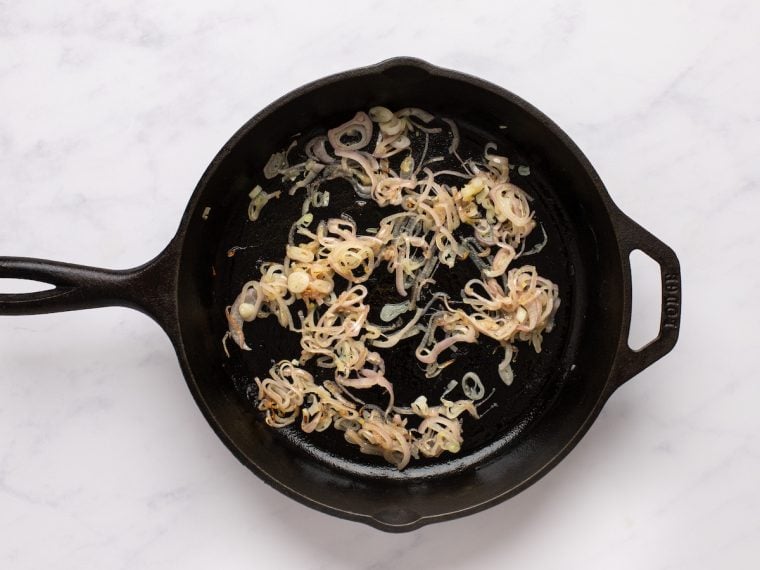
Step 2: Add the vegetables. Add the cooked veggies to the skillet and stir to combine—that’s your filling.

Step 3: Whisk the egg mixture. In a large bowl, whisk together the eggs, heavy cream, salt, and pepper until well combined. (Whisk just until the yolks and whites are fully blended and the mixture is a uniform yellow—over-whisking can incorporate too much air, making the texture spongy instead of creamy.)
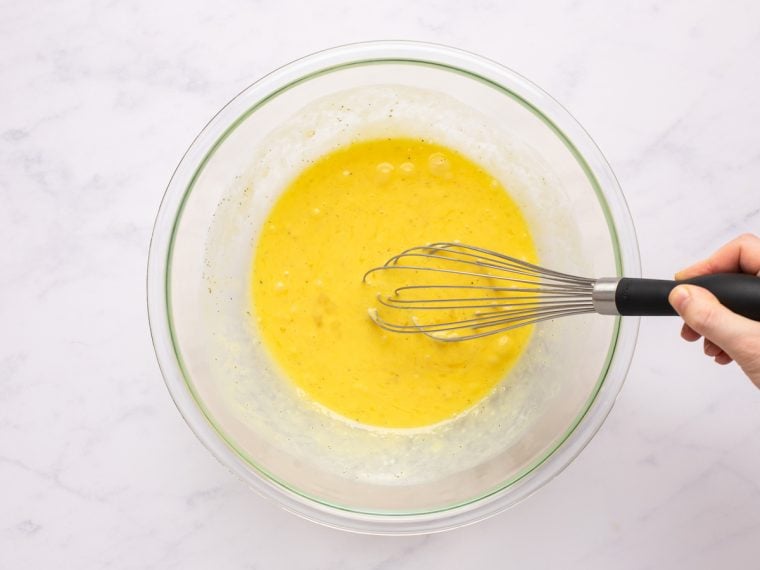
Step 4: Combine everything. Add the cooked vegetables and cheese to the egg mixture and stir to combine.
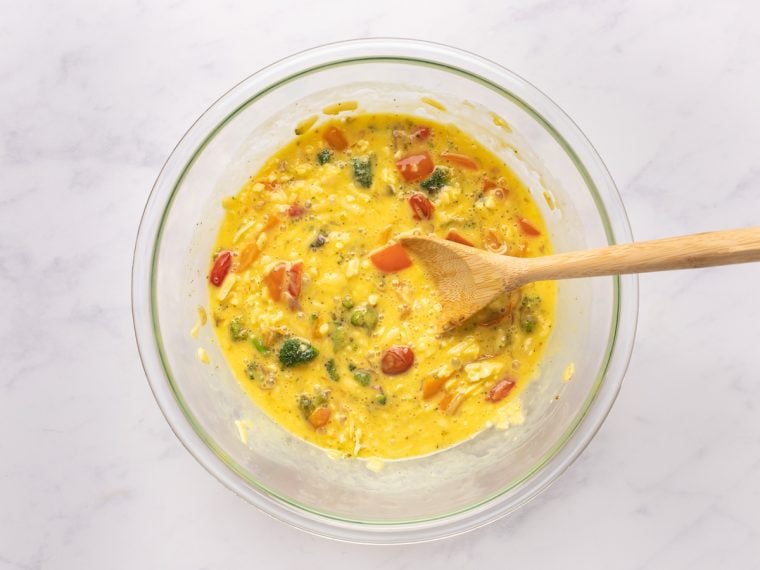
Step 5: Return to the skillet. Pour the mixture back into the skillet—no need to clean it first.
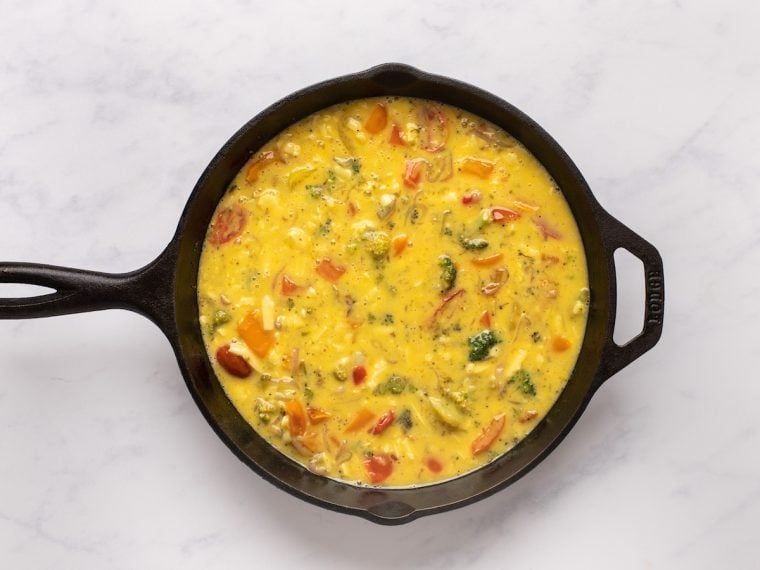
Step 6: Bake the frittata. Bake the frittata in a preheated 325°F oven until set, 20 to 23 minutes.
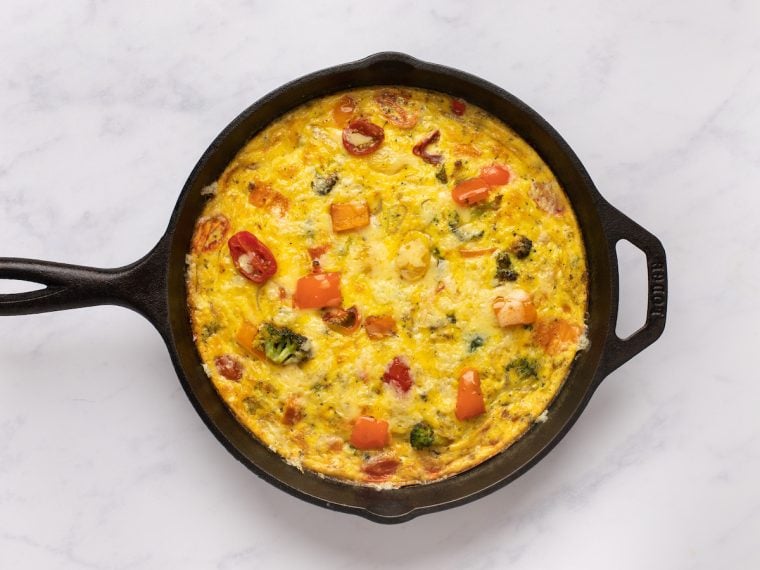
Step 7: Serve. After baking, place an oven mitt or dish towel over the hot skillet handle as a reminder that it’s hot—it’s easy to forget and accidentally grab it. Some people flip the frittata onto a platter, but I prefer to serve it straight from the pan—it’s easier, less likely to break, and makes cleanup a breeze. Frittatas can be refrigerated for up to 3 days or frozen for up to 3 months.

You May Also Like
Best Basic Frittata Recipe
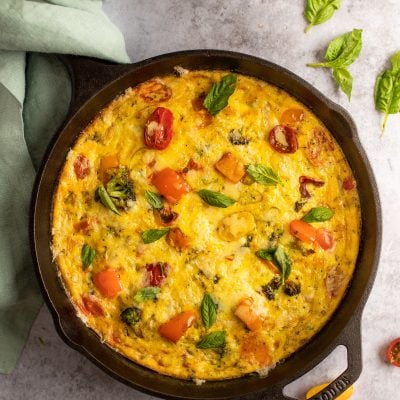
Ingredients
- 2 tablespoons extra virgin olive oil
- ¾ cup thinly sliced shallots, from 2 to 3 shallots
- 2 cups seasoned, cooked vegetables or greens
- 8 large eggs
- ⅓ cup heavy cream
- ½ teaspoon salt
- ¼ teaspoon freshly ground black pepper
- 1¼ cup shredded cheese, such as Cheddar or Gruyere
Instructions
- Preheat the oven to 325°F (165°C), and set an oven rack in the middle position.
- Heat the oil in a 10-inch (25-cm) cast iron or ovenproof nonstick skillet over medium heat. Add the shallots and cook, stirring frequently, until softened, 3 to 4 minutes. Do not brown. Add the cooked vegetables and stir to combine.
- In a large bowl, whisk together the eggs, heavy cream, salt, and pepper.
- Add the cooked vegetable mixture and cheese to the egg mixture and stir to combine. Pour the mixture back into the pan (no need to wash it), then place it in the oven and bake until set, 20 to 23 minutes. Immediately place an oven mitt over the pan handle to remind yourself that it is hot (it's easy to forget and burn your hand, and the handle stays hot for a long time). Serve the frittata directly from the pan, or use a rubber spatula to loosen the edges and slide the frittata onto a serving platter.
Notes
- If you'd like to add savory additions to your frittata, 1 to 1½ cups of shredded chicken or crumbled sausage is ideal. A touch of crumbled cooked bacon or smoked salmon requires around ½ cup.
- Make-Ahead/Freezer-Friendly Instructions: The cooked frittata will keep well in the refrigerator for up to 3 days. It can also be frozen for up to 3 months. Remove the frittata from the freezer about 24 hours prior to serving and reheat it in the microwave or, covered with foil, in a 300°F oven until hot in the center.
Nutrition Information
This website is written and produced for informational purposes only. I am not a certified nutritionist and the nutritional data on this site has not been evaluated or approved by a nutritionist or the Food and Drug Administration. Nutritional information is offered as a courtesy and should not be construed as a guarantee. The data is calculated through an online nutritional calculator, Edamam.com. Although I do my best to provide accurate nutritional information, these figures should be considered estimates only. Varying factors such as product types or brands purchased, natural fluctuations in fresh produce, and the way ingredients are processed change the effective nutritional information in any given recipe. Furthermore, different online calculators provide different results depending on their own nutrition fact sources and algorithms. To obtain the most accurate nutritional information in a given recipe, you should calculate the nutritional information with the actual ingredients used in your recipe, using your preferred nutrition calculator.
Gluten-Free Adaptable Note
To the best of my knowledge, all of the ingredients used in this recipe are gluten-free or widely available in gluten-free versions. There is hidden gluten in many foods; if you're following a gluten-free diet or cooking for someone with gluten allergies, always read the labels of your ingredients to verify that they are gluten-free.
Comments
Add a Comment Cancel reply
This site uses Akismet to reduce spam. Learn how your comment data is processed.
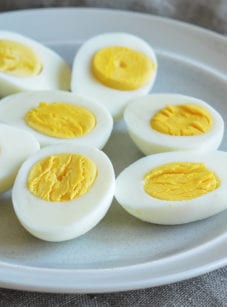
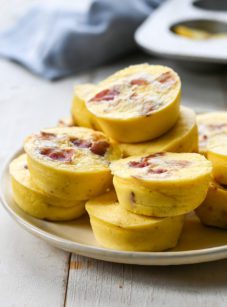
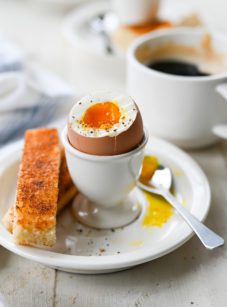


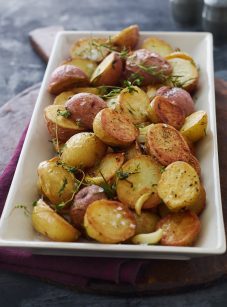
I never have cream on hand unless making a special dessert (a few times a year at most). Only 2% milk or yogurt. So, what am I supposed to do with recipes like this that call for a few tablespoons?
Hi Susan, you can get away with using 2% milk here – the frittata just won’t be as rich.